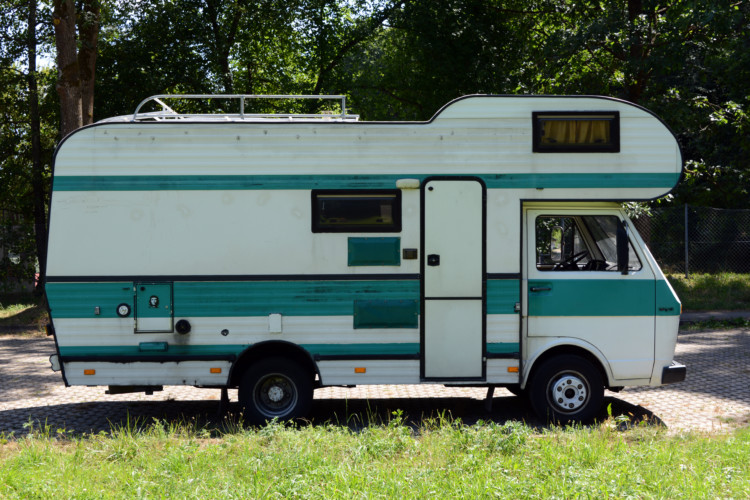
You’ve decided to buy an RV. Congratulations! Now you need to decide if you want to buy new or get a used RV. Either way, you should know the pros and cons before you buy.
RVs aren’t cheap. Even a modest travel trailer can cost tens of thousands of dollars, and if you want luxury, you could be looking at around $500,000. That’s when looking for a used RV becomes your best bet.
You can always customize that used RV with fancy upgrades: a $14 wall plate does the same thing as the expensive USB charging port options, for example. You do, however, want to make sure you don’t get the wrong used RV.
Make sure it’s not too old. Many developed campgrounds actually restrict by age of the RV they allow in their campgrounds. The best bet is to look for something that’s under 10 years old. Also, the older the RV, the more chance of wear and tear, which could become an expensive repair bill.
When you find a used RV, you want to inspect it very carefully. If you follow these steps, you should be able to determine if the RV you’re thinking of buying is perfect for you.
The Roof
One of the most important pre-sale checks you can make is the roof. You don’t want a roof that leaks, as that could mean massive damage that is often hidden from casual view. Rot inside the walls can weaken the whole structure and unseen mold can make you sick.
When you check the roof, look for:
- All seams and joints. Check them for cracks, rips, tears, or worn spots.
- The condition of the sealants and caulking. Does it look old and dried out? Pay extra attention to the front and back seams.
- Inspect all vent covers and check the seams underneath.
- Are the gutters in working condition? If you can, spray it down with a hose and see if the gutters are shedding the water.
- Pull off the waste tank and fridge vent covers. You want to check into the vents for blockages that could be caused by birds, rodents, or insect nests.
Windows and Doors
Make sure the seams and sealants are in good shape. Check for tears in the bug screens. You want to check for leaks, and if there’s films on the windows, are they cracking? If they’re double-paned you want to check for fogging in between. Check for missing hardware on doors, cabinets, and drawers, and finally make sure locks and latches work well.
Exterior Walls
Walk around the RV and see if there are any cracks, bubbles, or bulges. Look at the seams. Are the areas with sealant or caulking clean with no cracking or peeling? Is there any loose molding or mounting screws? You also want to make sure the walls look square. If a section of wall looks off-balanced, it’s usually a sign of underlying frame damage.
Electrical Systems
You need to check each AC breaker to make sure they feel stiff when switching. Run all the circuits…excessive heat is a warning sign. Blown fuses may be easy to replace, but it is a good idea to check that, too.
Have a look at all the fixtures and make sure they work without overheating. An important thing to do after this is check the main power cord for defects. Pay close attention to the metal plug prongs and ensure they have no arc damage. You can bring an inexpensive circuit tester to check all the AC outlets for power.
Battery Bank
It’s very important to inspect the battery bank. This is usually in its own vented box. There should be no corrosion on the connections, the wires should be in good shape, and there should be no size of overheating. A good thing to do is check the voltage measurement with a multimeter. You want it to be between 12.6 and 12.8 volts when not plugged in. If the battery is a lead acid type, test each cell with a hydrometer. You also want to check the date code on battery labels to make sure it’s not older than 5-7 years.
Cooling: A/C, Vents, and Fans
When checking the A/C you want to make sure there’s no signs of water leaks from the roof gasket and the filter is in good condition. A gummed up filter means there has never been basic maintenance on it. The condenser and evaporator fins on the rooftop should show no damage and should not be clogged with debris. Check the wiring and electrical connectors. Make sure the fan spins freely without wobbles or squeaks.
If you run the A/C for 10-15 minutes you should get a good clue if they work well. If you have an IR thermometer gun, the difference of 18-22 degrees would be normal.
Gas System
Make sure the gas system has been inspected and certified. It’s even the law in most jurisdictions to have this done before sale. Check the age of the propane cylinders and the condition of the rubber hoses, regulator and tank switch over the valves. Use your nose: Sniff for any signs of a propane leak.
You want to be sure the gas furnace fires up quickly and the fan has no squeaks, squeals, or rattles. The output vent should have heat and a decent air flow. Remove the furnace access panel to see if the area around the furnace is clear of dust and debris.
Plumbing Systems
If you can, take the RV for a quick spin after filling the fresh water and waste tanks. Look for leaks under the RV and dump the tanks to look for the good flow and smooth feel to the waste gate valves.
When checking the condition of the water pump, make sure the wiring and hoses are in smooth operation without leaks. Make sure it can supply a consistent stream to all faucets.
Open the interior and exterior access panels to the water heating and check that for plumbing and wiring. If you fire up the heater in gas mode it should ignite quickly with a mostly blue flame. In electric mode it should come to full temp.
Try turning on and off all faucets in the toilet and plumbing for good flow and no leaks. The drains need to be able to work properly. Check for leaks around the toilet and bowl seat and make sure that it holds water. You also want to check the shower head and the seal on the door and stall walls.
Kitchen Appliances
Make sure all the appliances are in working order. If you have a LP gas stove, light it to make sure the burners and oven works. Test the fridge in both electric and gas mode. You can use an IR thermometer gun to check the temperatures in the freezer and fridge for proper cooling. You want to make sure the access panels on the outside have no debris and are clean and that the drain hose is in good working condition. The auto switch should be working. And when you remove electricity, you should hear a sparking noise outside and be able to see a tiny blue flame in the burner area.
RV Undercarriage
Under the RV is as important as under. You want to make sure the axels and suspension components are not excessively corroded and don’t have any broken parts. The underbelly covering should be in good condition and the tires should be in good condition. Any tires older than 5-7 years need to be replaced, especially if the RV is a trailer.
Final Checks: Safety Equipment, Entertainment, and Nooks and Crannies
Finally, you have the last checks: Entertainment equipment…does it turn on and run? Are there signs of water leaks, dry rot, mold or anything else in the nooks and crannies? Is there an up to date fire extinguisher and functioning smoke, carbon monoxide, and LP gas detectors?
All of this may seem like a lot to just buy a used RV, but remember: this check might save you thousands, or even hundreds, of dollars! Good luck, and happy camping!
